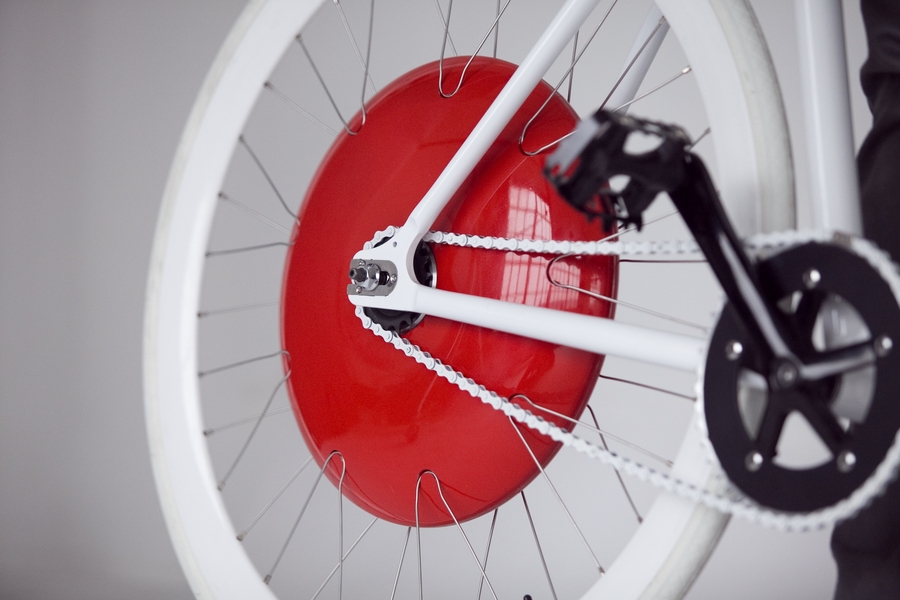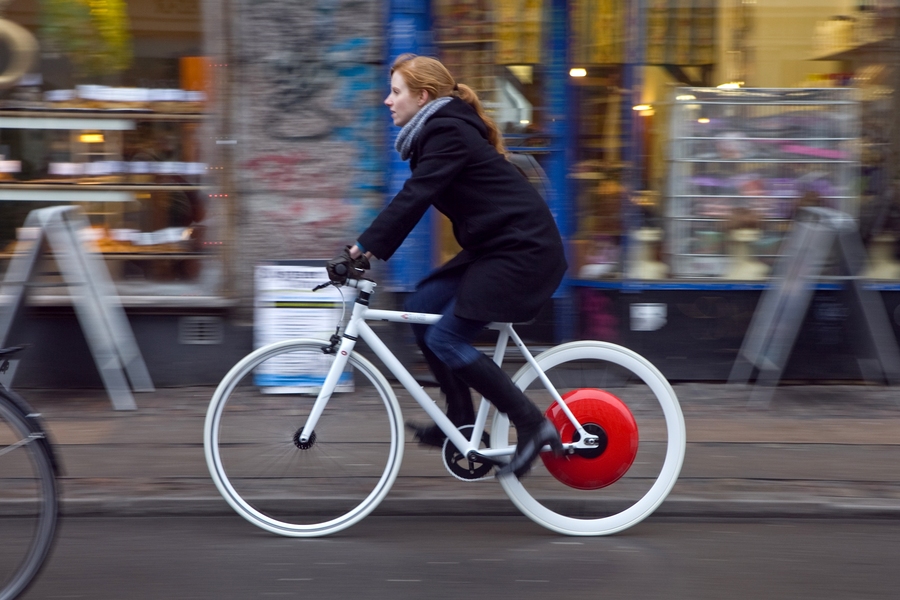It looks like an ordinary bicycle wheel with an oversized center. But packed inside that unassuming hub is a veritable Swiss army knife’s worth of electronic gadgets and novel functions.
The new wheel, developed by researchers at MIT, can store energy every time the rider puts on the brakes, and then give that power back to provide a boost when going uphill or to add a burst of speed in traffic. But there are also a variety of extra functions hidden within the hub of this new wheel, which is designed to be easily interchangeable with any standard bicycle’s rear wheel.
By using a series of sensors and a Bluetooth connection to the user’s iPhone, which can be mounted on the handlebars, the wheel can monitor the bicycle’s speed, direction and distance traveled, as well as picking up data on pollution in the air, and even the proximity of the rider’s friends. The resulting data can both help the individual rider — for example, by providing feedback on fitness goals — and help the city (if the user opts to share the information) by building up a database of air quality, popular biking routes or areas of traffic congestion.
All of the generating, power assisting, sensing and communications equipment fits inside a plastic housing in the hub of the wheel, connected to the standard rim by a novel system of spokes. Dubbed the Copenhagen Wheel, it was developed by Carlo Ratti, associate professor of the practice in MIT’s Department of Urban Studies and Planning (DUSP) and director of the SENSEable City Laboratory, and his team.
The whole generating and power-assisting system can be controlled through the pedals, requiring no switches or dials. Pedal backwards, and the regenerative braking is engaged, helping to recharge the system’s batteries; pedal fast, and you get the extra boost of power. “Everything is controlled by your feet,” Ratti explains.
In addition, “The wheel, thanks to the energy it harvests, becomes something that helps you keep track of your fitness,” he says, by recording the mileage that you travel. That information could also be shared, for example, with employers, who might get credits for the avoided pollution for employees who commute by bike. It also contains sensors that can monitor levels of carbon monoxide, nitrous oxides, temperature, humidity and noise, and a GPS that can track position.
There are a variety of bicycles on the market now that can provide an electrical boost, but Ratti says his team’s is different because of its extra functions, modern design and ease of use. The city of Copenhagen, site of the UN Conference on Climate Change, has been a sponsor of the research (along with the Italian company Ducati, and the Italian environment ministry), and the city has already placed an initial order for some of the innovative bicycle wheels, to be used by city workers.
The system was demonstrated in Copenhagen on Dec. 15 for the benefit of conference attendees, and for a gathering of 400 city mayors from around the world.
‘Biking 2.0’
Assaf Biderman, associate director of the SENSEable City Lab, says that Copenhagen makes a perfect testbed for the system because of its heavy bicycle usage. “It’s a city with 500,000 people and 600,000 bicycles,” he says. “This device can change your experience of riding, and change your experience of the city.” Moreover, data about the daily routes bicyclists use could help city planners determine where more bike paths are needed, and fine-grained data on pollution might help officials pinpoint its sources.
“Over the past few years we have seen a kind of ‘biking renaissance,’ which started in Copenhagen and is now transforming the urban experience in many cities from Paris to Barcelona or Montreal,” says Ratti. “We could also call it a ‘Biking 2.0’ revolution, whereby cheap electronics allow us to augment bikes and convert them into a more flexible, on-demand system.“
Ritt Bjerregaard, the Lord Mayor of Copenhagen, says the wheel may well help her city achieve its goal of getting half of its citizens to bike to work or school every day. “For us, this project is part of the answer to how can we make using a bike even more attractive,“ she says.
But some experts are more circumspect. Rob Sadowsky, executive director of the Active Transportation Alliance, a Chicago-based organization that promotes increased use of bicycles in urban areas, says that some elements of the Copenhagen Wheel — the ability to track and post on social networks, for instance — differentiate it from other add-on devices already on the market. However, he questions whether electric bikes and related technologies can boost the number of cyclists on the roads.
“While electric bikes have a role to play, in communities such as Chicago, I'd say that it would very minimal,” he says.
Christine Outram, a research fellow in DUSP who has been working on the project, explains that the two-way link to a user’s iPhone, which can be mounted to the handlebars, can also be used to control some functions, as well as to display information.
The extra functions could provide a wealth of data to help the city analyze a number of environmental factors. Outram says that at present, the whole city of Copenhagen has just three sensors monitoring pollution, all mounted on tops of buildings. If the new bicycle wheel becomes widely adopted, there could be thousands of sensors all over the city at street level. “Now, through a small amount of technology, we could have an incredible amount of information,” she says.
Ratti says the team expects to have the wheel in production by the end of next year. The retail price has not yet been determined. Though the prototypes cost hundreds of thousands of dollars each because of all the research involved, their analysis shows that a regular production model can be “competitive with existing electric bicycles,” he says.
“We’re showing that biking can really help some of today’s problems in cities — congestion, pollution, climate change,” says Ratti. For the bicycle user, there’s another advantage to the embedded electronics: security. Because of its built-in Bluetooth connection to the user’s cellphone, the wheel can be set so that the bicycle will only function if the user’s cellphone is within range. “The bicycle will recognize the presence of the phone and unlock,” Ratti explains. “When you leave, it locks,” without requiring any specific action by the user.



Press Mentions
Boston Globe
In an article for The Boston Globe about electric bike systems, Hiawatha Bray writes about the Copenhagen Wheel, a battery-powered wheel developed by MIT researchers. “The wheel turns almost any standard bike into a two-wheeled Tesla,” writes Bray, who recently tested the wheel on the streets of Boston.
CNBC
The Copenhagen Wheel, created by Senseable City Lab researchers, transforms a regular bicycle into a semi-autonomous mode of transport, writes Bob Woods for CNBC. “We realized that unless you somehow change the bike, it's hard to imagine it as a solution for transportation, and that means increasing its capacity to go farther,” explains Assaf Biderman, the lab’s associate director.





